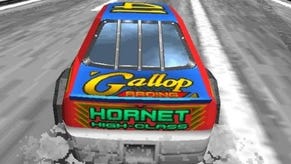Daytona USA was one of the miracles of the XBLA era, so grab it while you can
Let's go away.
Sometimes you really don't know how good you've got it. Just over a decade ago Sega dropped a batch of Model 2 ports on PlayStation 3 and Xbox 360, providing impeccably presented emulations of some of the games that carved its reputation in 90s arcades. Virtua Fighter 2, Cyber Troopers Virtual-On and Sonic the Fighters all received near-immaculate re-releases, but the best of the lot was the first to arrive: Daytona USA, AM2's almighty racer which, back in 2011, got a port that had no right being as good as it was. It's about to be delisted from Microsoft's marketplace, so I'd strongly suggest you grab it while you can.
What makes it so special? First off it's worth acknowledging the impact of the 1994 original - or at the very least the impact it had on me and millions of other impressionable young players. 3D games weren't anything particularly new or novel - I remember my first glimpse of Virtua Fighter, running on Sega's Model 1 board, in the dark corner of a bowling alley - but the texture-mapping introduced by the Model 2 felt like a bigger step forward still. Somehow I was lucky enough to find myself at London's Trocadero when it made its debut here in the UK, a large crowd gathered around as we all patiently waited to take our turn behind the wheel. It felt like a glimpse of the future.
There's more to Daytona USA than technical prowess, though, and it stands out as an icon of Sega's legendary 90s output. It's not quite as groundbreaking as Virtua Racing, and I don't think it plays quite as well as Sega Rally Championship, but Daytona USA has a special charm all of its own. It's the arcade racer as a rhythmic experience, something its designer Toshihiro Nagoshi would expand upon in his Edge column nearly a decade after the game's original release.
"When I develop a game, not only driving games, rhythm is the factor I care the most about," Nagoshi wrote in one of the rare occasions he wasn't celebrating the fine whiskies he so adores (though the analogy does come as part of an appraisal of Men in Black 2, proving he's always a man of esoteric tastes). "The curves and bumps give the tempo of the game," he continued, "while the handling provides the rhythm."
That rhythm was explicit in the prog fusion of Nagoshi's brilliant F-Zero GX, but it's Daytona USA that'll always eclipse it - even if it's not quite as refined, it's a crowd-pleasing stadium rock-out of a racer, one we can all sing along to even if we can't quite remember all the words.

I played through its three courses last night and it blew my mind all over again with its verve and character. The port is even better than I remember, with the all-important gate shift mapped out to the face buttons so you can slam from 4th to 2nd in an instant to kick the back end out, while there are incredible delights like the Karaoke mode that removes all time pressures and lays the lyrics to each song out on-screen so you can belt out the classics. It goes beyond arcade perfect, and combined with a wheel is the best way to experience this Sega classic outside of an arcade itself. In fact, in some ways it's even better.
It's a shame it's being taken down, though I'm at least grateful for one last chance to grab it before it's pulled on February 7th so it can sit on my Xbox harddrive forever more. If only Sega had ever got around to sorting its Model 3 emulation out so it could give us the brilliantly overstated sequel Daytona USA 2 - a miracle I'm not holding out too much hope for.



